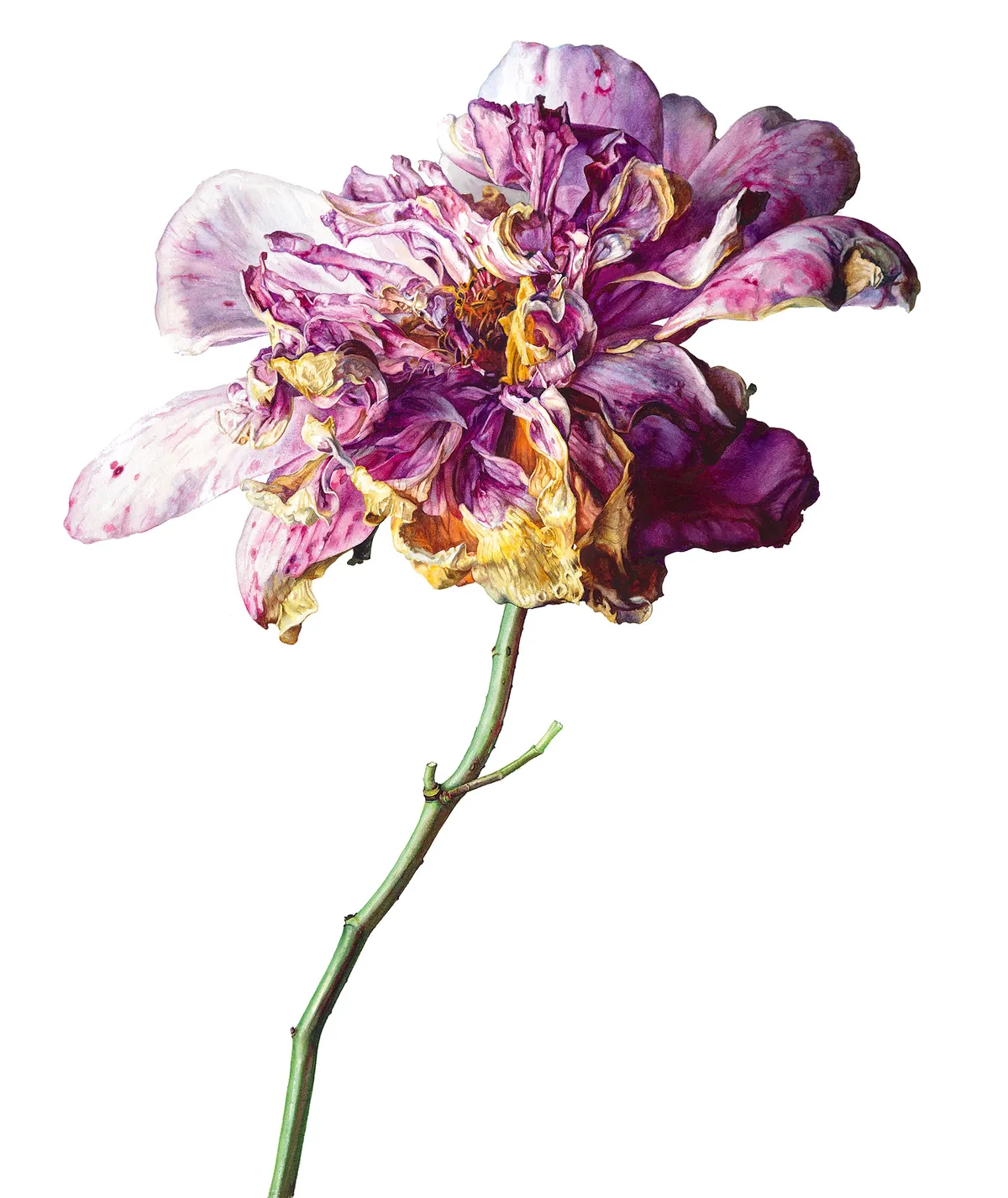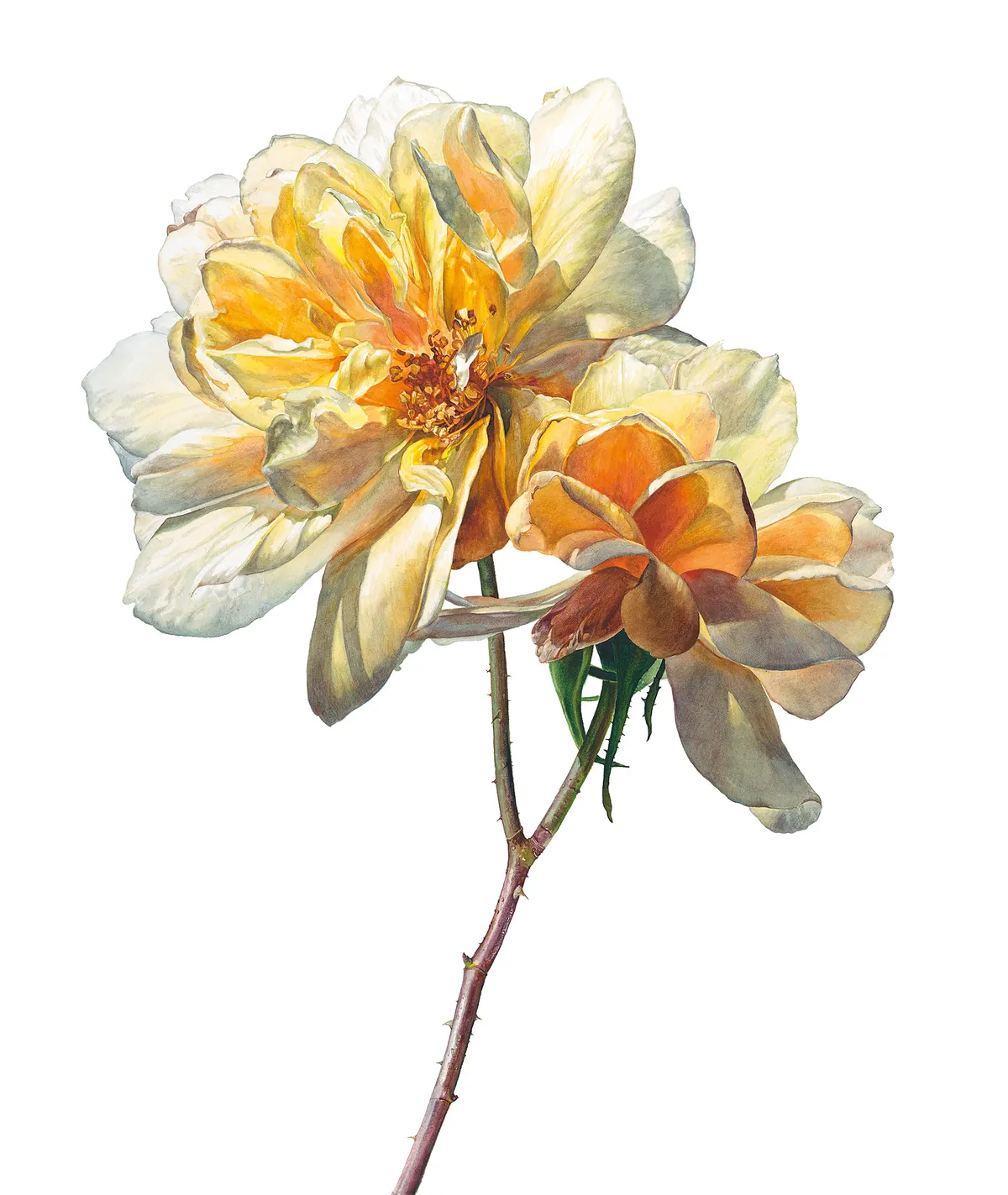Roses appear in art sometimes simply as beautiful flowers but historically they were often used to impart extra meaning to the beholder. In paintings of the Madonna, a trellis of roses may represent a hortus conclusus or enclosed garden, and roses are frequently found winding their way round the edge of illuminated manuscripts, attractively and meaningfully.
Herbals and botanical volumes aimed for accuracy while flowers in fabric and embroidery often tended towards stylistic artistry. Sometimes it is possible to identify an exact cultivar as artists would often portray the flowers that were popular at the time. In the 17th-century still life paintings, especially in the Netherlands, aimed for realism, with artists such as Jan Brueghel and Jan van Huysum depicting all flowers but especially favouring the lush centifolia roses that were popular at the time.

‘Enigma’ Rosa Mortimer Sackler (=‘Ausorts’) AGM (above) The inner petals have become curled and irregular, weaving around like a sea urchin, and yet the outline is still unmistakably a rose. I love these colours: the lilacs, pinks and purples set among the orangey yellows, each enhancing the other.
Rosie Sanders
Between 1817 and 1824 three books were published containing what are probably the most famous rose paintings: Redouté’s Les Roses. Pierre-Joseph Redouté had spent the time of the Revolution quietly painting and in 1800 was appointed Flower-Painter to the Empress. Josephine undoubtedly inspired Redouté’s Les Liliacées but Les Roses seems to have been an independent project. Redouté travelled all over France, visiting the best gardens, and the volumes contained detailed paintings of all the roses available in France at the time. Redouté obviously has had a rose named in his honour [Rosa Redouté (= ‘Auspale’)], a soft pink, English, old rose hybrid, bred by David Austin. Another 19th-century painter, Henri Fantin-Latour, reputedly favoured roses above other flowers and has a centifolia-type pink rose [Rosa ‘Fantin-Latour’] named after him.
Lawrence Alma-Tadema had roses sent from France every week to ensure his painting’s realism
Pre-Raphaelites painted dog roses and other wild briars while Monet planted and painted roses at Giverney. John Singer Sargent described the problems of painting roses from life when he was working on Carnation, Lily, Lily, Rose in 1885-6, which depicts two girls in a flower garden at dusk. He could only work for a short time each day when the light was exactly right and, as autumn approached, the real flowers were increasingly replaced with artificial ones and the girls donned woollen vests under their romantically flimsy dresses. While he was painting The Roses of Heliogabalus in 1888, Lawrence Alma-Tadema had roses sent from the South of France every week to ensure the painting’s realism.

'All in the golden afternoon’ Rosa Graham Thomas (=‘Ausmas’) AGM (above) I can’t make up my mind what colour this rose is. It is Graham Thomas and the description of it is a rich yellow and I think I remember it being yellow when I planted it several years ago but this summer it is not yellow. The buds open vermillion with bright green leaves and the flowers open a brownish orange with a yellow glow at the centre.
Rosie Sanders
Following the tradition of Redouté, Alfred Parsons was commissioned by the renowned horticulturist Ellen Willmott (of Warley Place in Essex) to provide illustrations for her book The Genus Rosa. Her plan was that the book would supersede Redouté’s work but the couple seem to have been spectacularly ill-matched: Parsons objected to Miss Willmott’s dictatorial manner and became awkward about the reproductions of his paintings, she kept changing her mind and was late in supplying the text and John Murray, the publisher, saw his costs spiralling out of control. Eventually the book was published in 1910 but failed to capture the rose-growers’ interest or make Miss Willmott her much-needed fortune.
In the 20th century artistic depiction of roses moved away from the botanical, firstly to the more stylised shapes of Art Nouveau and then to the surrealist flowers of René Magritte and the giant works of Georgia O’Keeffe and Cy Twombly, whose richly coloured flowers are literally human-sized. Still clearly roses but far removed from Redouté’s botanical images.

‘Red as cherry harvest’Rosa ‘Tuscany Superb’ AGM (above)A painting of ‘Tuscany Superb’ looking decidedly wayward. It was a rewarding colour to paint with magenta, violet and rose and deep, unfathomable shadows. It reminded me of those dark luscious cherries that fill your mouth with crimson juice.
Rosie Sanders
Rosie Sanders is an artist whose work has been displayed in many galleries, including the Shirley Sherwood Gallery of Botanical Art in the Royal Botanic Gardens, Kew. She has been awarded five Gold medals by the RHS and won the Royal Academy miniature award. She is represented by Jonathan Cooper gallery. The above is taken from Rosie Sanders’ Roses: A Celebration in Botanical Art, published by Batsford, priced £30.